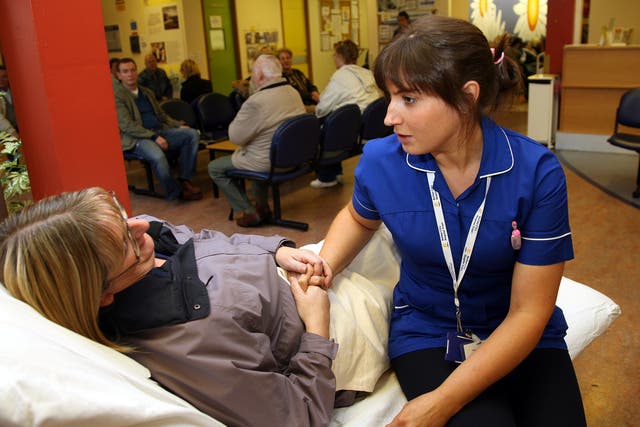The NHS needs 13,000 more beds across the UK to improve “grim” A&E waits, ambulance response times and handover delays outside hospitals, a new report has found.
The Royal College of Emergency Medicine’s Beds in the NHS report, published on Tuesday, said the health service has lost almost 25,000 beds across the UK since 2010-11.
It said the UK has the second lowest number of beds per 1,000 people in the EU at 2.42 and had seen the third largest drop in beds per 1,000 population in the EU between 2000 and 2021 at 40.7%.
The loss of beds has led to a “sharp increase” in A&E waiting times, ambulance handover delays, delayed ambulance response times, cancelled elective surgeries and “unsafe” bed occupancy levels, the report added.
England-wide NHS data for April shows ambulance trusts across the country missing a raft of targets, including too-slow response times to the most urgent incidents.
NHS England figures also show A&Es have been seeing record numbers of so-called trolley waits and record low performance against the four-hour A&E waiting-times target.
The college’s report said 13,000 staffed beds are required in the NHS across the UK to drive “meaningful change and improvement”, which includes a “significant” improvement in A&E waiting times, ambulance response times, ambulance handover delays and a return to safe bed occupancy levels.
It recommends opening 4,500 beds before winter, with the rest within the next five years.
The college’s vice president Dr Adrian Boyle said the urgent and emergency care system was in crisis, with widespread staffing gaps leading to a shortage of staffed beds.
He added: “The situation is dire and demands meaningful action.
“Since 2010-11 the NHS has lost 25,000 beds across the UK, as a result bed occupancy has risen, ambulance response times have risen, A&E waiting times have increased, cancelled elective care operations have increased.
“All evidenced by the fall in four-hour performance, the increase in 12-hour waits, the increase in delayed ambulance response times and rise in ambulance handover delays.
“These numbers are grim; they should shock all health and political leaders. These numbers translate to real patient harm and a serious patient safety crisis.
“The health service is not functioning as it should and the UK Government must take the steps to prevent further deterioration in performance and drive meaningful improvement, especially ahead of next winter.”
The college also said the fall in bed numbers and “deteriorating” performance are having an impact on patient care.
It added that staff are unable to provide “quick and effective high-quality care” and were facing increasing levels of burnout, exhaustion, and moral injury, while patients are distressed by long-waiting times.
The latest NHS England figures show a record 24,138 people had to wait more than 12 hours in A&E departments in England in April from a decision to admit to actually being admitted – so-called trolley waits.

Some 72.3% of patients in England were seen within four hours at A&Es in April, the second lowest percentage in records going back to November 2010.
The average response time last month for ambulances in England dealing with the most urgent incidents – defined as calls from people with life-threatening illnesses or injuries – was nine minutes and two seconds.
This is down from nine minutes and 35 seconds in March, which was the longest average since current records began in August 2017.
The NHS Confederation said a fully-funded long-term plan for the health and social care workforce was needed as well as immediately investing more cash in social care to make sure patients medically fit for discharge can be cared for in the community.
Rory Deighton, acute lead at the NHS Confederation, said: “This report lays bare the scale of the challenge the NHS is facing in terms of capacity and workforce.
“NHS leaders see first-hand that capacity in urgent and emergency care and ambulance services can simply not cope with the level of pressure we are seeing in the whole system.
“It is only with these additional measures that the NHS can operate as a resilient and sustainable system that can move through the elective backlog as efficiently as possible and provide the best possible care.”
NHS Providers’ interim chief executive Saffron Cordery said that any expansion of bed numbers must be matched by more staff to look after more patients.
She added: “Overstretched NHS staff are working flat out to clear care backlogs that built up over the pandemic.
“But pressures and problems predating the pandemic persist, including severe workforce shortages.
“Without a fully-funded, long-term workforce plan from the Government patients will continue to pay the price of an understaffed health service which is doing all it can to meet growing demand and deliver care to everyone who needs it as quickly as it can.”
A Department of Health and Social Care spokesperson said: “We recognise the pressure on urgent and emergency care services and we have set out our plan to help tackle the Covid backlog, backed by record investment.
“There are record numbers of doctors, nurses and overall staff working in the NHS, and we have commissioned NHSE to develop a long-term workforce strategy.
“The NHS is taking a range of actions, including providing an additional £50 million of funding to support increased NHS 111 call-taking capacity this year, to help people access urgent care when they need it.”




Comments: Our rules
We want our comments to be a lively and valuable part of our community - a place where readers can debate and engage with the most important local issues. The ability to comment on our stories is a privilege, not a right, however, and that privilege may be withdrawn if it is abused or misused.
Please report any comments that break our rules.
Read the rules hereLast Updated:
Report this comment Cancel